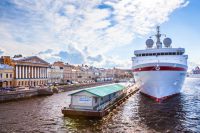Recently, in Punta Arenas, I paid my first visit to the Instituto de la Patagonia in several years. It’s actually an academic research institute, founded by local historian Mateo Martinic in the 1970s and affiliated with the Universidad by Magallanes, but it also features the Museo del Recuerdo, a mostly open-air museum that makes an ideal Punta Arenas excursion for anybody on a Patagonia vacation.
I hadn’t visited the Instituto’s museum recently because it hadn’t much impressed me in an earlier formative stage, and nothing I could see from the street – it’s on the main road into town from the north – really grabbed my attention. Still, after a visit to Norway in mid-2014, where I enjoyed Lillehammer’s Maihaugen museum – a sprawling collection of artifact-filled buildings dating back to the Middle Ages – I decided to give the Museo del Recuerdo another chance.
I was pleased I did so. While the Instituto can’t match Maihaugen’s lengthy history and financial resources – not to mention the actors who make Lillehammer a truly interactive experience – it’s assembled an impressive collection of structures and objects from the the 1880s to the 1950s. It deals with three main themes – the wool industry that spurred settlement and brought early prosperity, the local commerce that the wool sector supported, and the regional petroleum industry (this is the only part of Chile with crude oil, though it provides just a tiny percentage of the country’s consumption).
In that context, the open-air exhibits include shepherds’ caravans and shearing shed facilities, horse carriages (of many styles) and antique automobiles, houses and commercial buildings such as a bakery, and heavy equipment including steam tractors and oil derricks. Unfortunately, this time, I prowled the grounds after closing, and couldn’t see the collections of smaller artifacts and automobiles except by peering through the windows.
What’s missing here are the mansions of the families that made their fortunes from the Wool Rush of the late 19th century, but several of those – such as the Palacio Braun-Menéndez, home to the regional museum – are still on display downtown.
No comments yet
There are no comments on this post yet.






Leave a comment